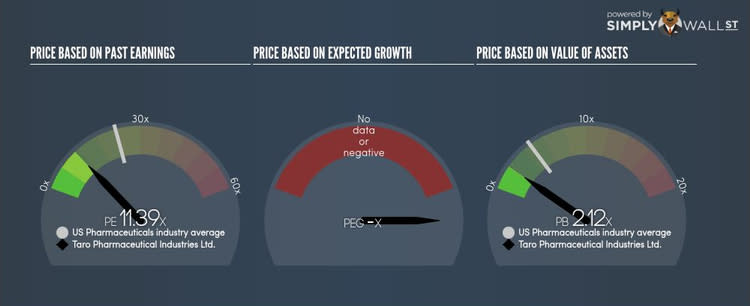Does Taro Pharmaceutical Industries Ltd’s (TARO) PE Ratio Signal A Buying Opportunity?

Taro Pharmaceutical Industries Ltd (NYSE:TARO) is trading with a trailing P/E of 11.4x, which is lower than the industry average of 23.4x. While this makes TARO appear like a great stock to buy, you might change your mind after I explain the assumptions behind the P/E ratio. In this article, I will break down what the P/E ratio is, how to interpret it and what to watch out for. See our latest analysis for TARO
Breaking down the P/E ratio
A common ratio used for relative valuation is the P/E ratio. By comparing a stock’s price per share to its earnings per share, we are able to see how much investors are paying for each dollar of the company’s earnings.
P/E Calculation for TARO
Price-Earnings Ratio = Price per share ÷ Earnings per share
TARO Price-Earnings Ratio = 111.9 ÷ 9.827 = 11.4x
The P/E ratio isn’t a metric you view in isolation and only becomes useful when you compare it against other similar companies. We preferably want to compare the stock’s P/E ratio to the average of companies that have similar features to TARO, such as capital structure and profitability. A common peer group is companies that exist in the same industry, which is what I use. TARO’s P/E of 11.4x is lower than its industry peers (23.4x), which implies that each dollar of TARO’s earnings is being undervalued by investors. As such, our analysis shows that TARO represents an under-priced stock.
Assumptions to watch out for
However, before you rush out to buy TARO, it is important to note that this conclusion is based on two key assumptions. Firstly, our peer group contains companies that are similar to TARO. If this isn’t the case, the difference in P/E could be due to other factors. For example, if you compared higher growth firms with TARO, then its P/E would naturally be lower since investors would reward its peers’ higher growth with a higher price. The second assumption that must hold true is that the stocks we are comparing TARO to are fairly valued by the market. If this is violated, TARO's P/E may be lower than its peers as they are actually overvalued by investors.
What this means for you:
Are you a shareholder? You may have already conducted fundamental analysis on the stock as a shareholder, so its current undervaluation could signal a good buying opportunity to increase your exposure to TARO. Now that you understand the ins and outs of the PE metric, you should know to bear in mind its limitations before you make an investment decision.
Are you a potential investor? If you are considering investing in TARO, looking at the PE ratio on its own is not enough to make a well-informed decision. You will benefit from looking at additional analysis and considering its intrinsic valuation along with other relative valuation metrics like PEG and EV/Sales.
PE is one aspect of your portfolio construction to consider when holding or entering into a stock. But it is certainly not the only factor. Take a look at our most recent infographic report on Taro Pharmaceutical Industries for a more in-depth analysis of the stock to help you make a well-informed investment decision. Since we know a limitation of PE is it doesn't properly account for growth, you can use our free platform to see my list of stocks with a high growth potential and see if their PE is still reasonable.
To help readers see pass the short term volatility of the financial market, we aim to bring you a long-term focused research analysis purely driven by fundamental data. Note that our analysis does not factor in the latest price sensitive company announcements.
The author is an independent contributor and at the time of publication had no position in the stocks mentioned.

